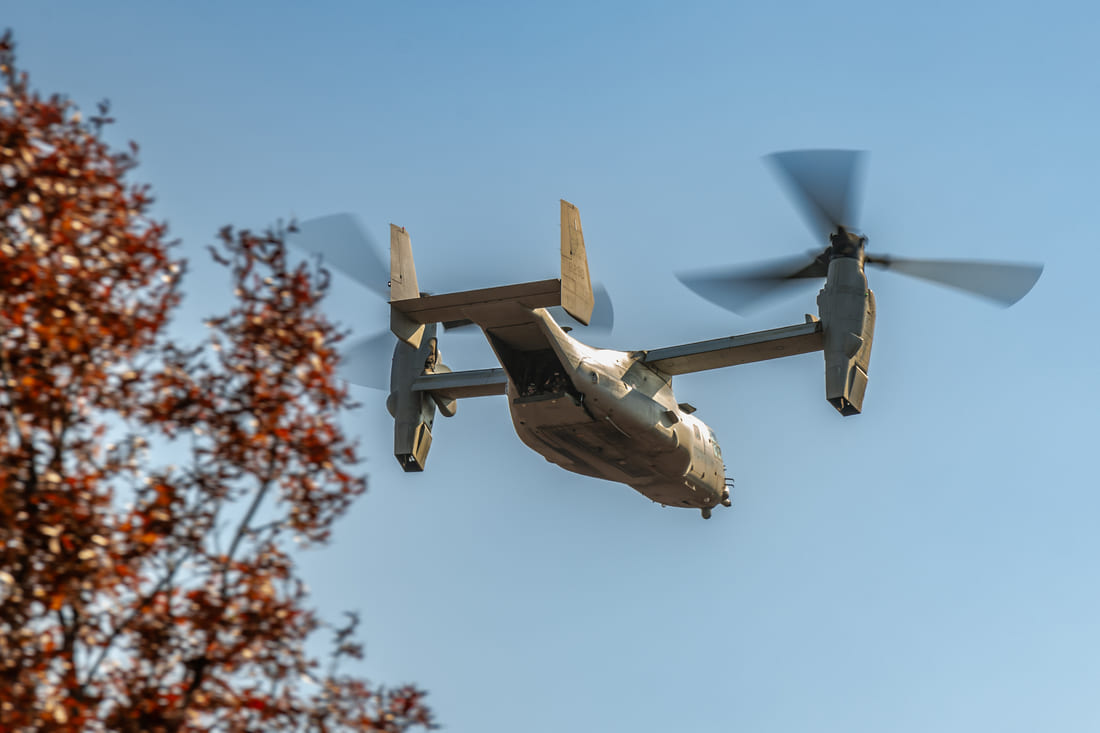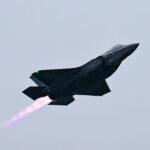Army aviation leaders at AUSA 2025 said they aim to field a collaborative combat aircraft–like capability within a couple of years. The effort runs beside launched effects and other unmanned projects, pairing a loyal wingman with Army rotorcraft in contested theaters.
AUSA Statements on CCA-like Fielding and FY26 Experiment
Brig. Gen. Cain Baker, who leads the Army’s Future Vertical Lift Cross Functional Team, told reporters, “That has been a focus for the last … really year. As we go forward, we’re watching closely in our experimentation to develop a full requirement, potentially to deliver our capability over the next couple of years.”
He linked the work to mass and survivability. “We’re following the other services very closely as they’re looking at this, this concept capability. I think for the Army, especially launched effects, it comes down to a discussion of mass. How do we provide mass to the commander, to sense with launch effects,” Baker said. He added, “A platform you know, a loyal wingman, a CCA concept, allows you to increase mass while also reducing the amount of aviators you got to have in the air. So we’re working with both the INDOPACOM [Indo-Pacific Command], we’re working with Europe to look at the capabilities that they need in order to deliver that mass and really survivability.” According to officials, coordination with both combatant commands is active.
Army planners set the annual aviation experiment in the second quarter of the current fiscal year to assess vendor offerings and maturity. Baker said, “We’re looking at vendors potentially to come out and market with us. That is what we’re really looking at, is what is the state of technology right now to develop a requirement that we can deliver?” Q2 of fiscal 2026 runs from January through March.
PEO Aviation Details on VTOL Options and Payloads
Program Executive Officer Aviation Gen. David Phillips said the service explored last fall what a Group 4 vertical takeoff and landing CCA-like option could look like and requested inputs from industry. “We received a very robust response from industry,” he told reporters. “It might not look like some of the things we’ve seen on the floor today,” he added.
A VTOL loyal wingman fits Army helicopter formations and dispersed launch sites, avoids runway dependence, and supports small-footprint operations in contested areas. Officials outlined payloads sized for Group 4 or 5 air vehicles that would team with Apache and Chinook units. Options include multi-spectral reconnaissance sensors for target handoff and electronic warfare or communications relay modules to extend brigade and division networks in cluttered terrain. According to industry sources, the Army expects any CCA-like vehicle to operate alongside launched effects rather than replace them.
Boeing CxR Tiltrotor Concept and Early Army Feedback
Boeing unveiled its Collaborative Transformational Rotorcraft concept during AUSA 2025 and outlined a variant tuned for helicopter teaming. “It’ll be a tiltrotor with two proprotors” and a gas turbine engine, said Chris Speights, chief engineer for the company’s vertical lift portfolio. “We believe that that’s going to provide the most mature, rapid ability to field.” The company described an approach that leans on known tiltrotor control transitions and flight-control software heritage.
Briefings described two roles within the CxR family. A combat configuration often referenced as a Collaborative Combat Rotorcraft would team with AH-64 units for deep attack and escort. A logistics configuration sometimes described as a Collaborative Logistics Rotorcraft would support CH-47 formations for autonomous resupply, casualty evacuation support, or off-board sensing. Targets shared with reporters placed speed roughly in the 200 to 250 knot range and payloads in the 1,000 to 2,000 pound class, with estimated gross weight between 5,000 and 7,000 pounds. Boeing said it is gathering Army feedback on mission systems and control interfaces so crews can manage a wingman from existing cockpits. Phillips cautioned the Army is keeping an open aperture and the eventual capability “might not look like some of the things we’ve seen on the floor.”
Joint Developments in USAF and Navy CCA
On October 31, the Air Force and Anduril disclosed the first flight of the YFQ-44A, a production-representative test vehicle for CCA Increment 1. General Atomics’ YFQ-42A flew earlier this year. According to officials, the Air Force is treating both as steps toward crewed-uncrewed teaming in contested environments. Army leaders said they are watching those efforts to inform requirement writing, especially where autonomy services, communications protocols, and control software could be shared.
Naval aviation moved forward with conceptual work for a carrier-based CCA and a separate award for a common control approach. According to industry sources, a shared control baseline across services would ease joint operations and cut the number of unique interfaces Army staffs must learn when operating in the same airspace.
Army units need wingmen that can stage from rough sites, stay with helicopters through ingress and egress in complex terrain, and endure harsh spectrum conditions. A VTOL air vehicle fits those demands and can lily pad between short stops with the formation. The recent first flight of YFQ-44A, paired with earlier YFQ-42A testing, supplies live data on human-machine teaming that the Army can study for its own requirement.
Near-Term Actions for Vendors and Units Ahead of Q2 FY26 Experiment
According to industry sources, several firms working VTOL wingmen with Army relevance are tuning autonomy for cooperative search, distributed electronic warfare, and dynamic task allocation, with hardware-in-the-loop testing before field events. Those teams are aligning airworthiness routes with Army regulation and drawing on safety evidence built under Air Force and Navy CCA efforts.
Baker’s emphasis on mass aligns to launched-effects development already underway. Smaller expendables extend reconnaissance and jamming and a larger VTOL teammate carries heavier sensors or weapons and serves as a higher-power relay. The experiment window early in calendar 2026 will let the Army measure crew workload, mission benefit, and survivability under strong jamming, then refine the requirement. Officials confirm the Army does not plan to wait for a perfect end state. The near-term push centers on mature autonomy and vehicle technologies, interfaces that fit today’s cockpits, and a VTOL air vehicle sized for useful payloads and survivability.
Shared development across services will continue to influence Army choices. If Navy and Air Force programs standardize autonomy services, data buses, health monitoring, and common control, the Army can reuse parts of that stack and focus on VTOL and austere-site needs. Procurement details matter, but the immediate work is clear. Get credible flight articles to the Q2 FY26 aviation experiment and collect data on teaming and workload. Our analysis shows the service has enough material to run a disciplined first look during that window.
REFERENCE SOURCES
- https://defensescoop.com/2025/10/20/army-aviation-collaborative-combat-aircraft-cca/
- https://www.aerotime.aero/articles/boeing-cxr-tiltrotor-drone-concept-ausa-2025
- https://www.airandspaceforces.com/anduril-cca-first-flight/
- https://breakingdefense.com/2025/10/army-looking-to-field-cca-like-capability-potentially-in-next-couple-of-years/
- https://breakingdefense.com/2025/10/boeing-drawing-up-new-tiltrotor-helo-wingman/
- https://breakingdefense.com/2025/09/exclusive-navy-taps-four-aerospace-primes-to-design-autonomous-drone-wingmen/
- https://www.anduril.com/article/anduril-yfq-44a-begins-flight-testing-for-the-collaborative-combat-aircraft-program/
- https://theaviationist.com/2025/10/31/anduril-yfq-44a-cca-first-flight/



